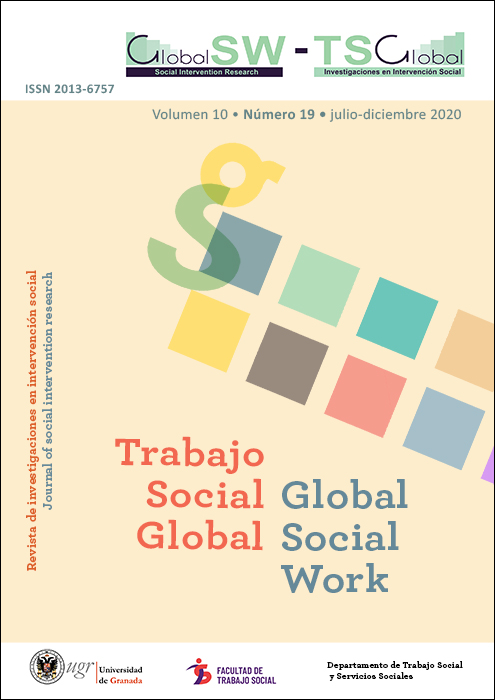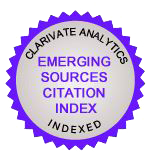Una revisión del concepto de exclusión social y su aplicación a la sociedad española tras la crisis económica mundial. Una visión de proceso.
DOI:
https://doi.org/10.30827/tsg-gsw.v10i19.13582Palabras clave:
Exclusión social, Paradigmas de la exclusión, Pobreza, Crisis económicaResumen
En este texto se realiza una revisión general de las aportaciones de las ciencias sociales en relación al concepto de exclusión desde sus orígenes hasta su utilización contemporánea, prestando especial atención a sus principales paradigmas: el paradigma de la solidaridad, el de la especialización y el del monopolio. Para definir la exclusión social tal y como la conocemos en la actualidad, en primer lugar, se hace necesario apuntar cuáles son sus características principales y analizar el fenómeno como proceso. A partir de este análisis se realiza una propuesta teórica sobre cuáles serían las posibles trayectorias generalizadas de la exclusión social que parten de diferentes orígenes o momentos vitales. La curva de la exclusión-inclusión social va desde escenarios de plena integración hasta la exclusión más extrema. A continuación, se examinan los efectos de la crisis económica del año 2008 y los tipos de exclusión social en la sociedad española actual, apuntando brevemente cuál es el punto de partida ante lo que ya se ha vaticinado como una nueva crisis: la pandemia del Covid19. Se concluye evidenciando el cambio de paradigma en cuanto a la comprensión de la exclusión social en los últimos años de la época democrática en España.
Descargas
Citas
Casado Pérez, D. (2007). Sociología de la pobreza. En M. Pérez Yruela (Comp.) La sociología en España (pp. 617-643). Madrid: CIS.
EAPN-ES (2020). El estado de la pobreza. Seguimiento del indicador de pobreza y exclusión social en España 2008-2019. Madrid: EAPN-ES.
Eurostat (2019). People at risk of poverty or social exclusion (Europe 2020 strategy). Bruselas: Eurostat.
FOESSA (2008). VI Informe sobre exclusión y desarrollo social 2008. Madrid: Fundación FOESSA y Cáritas Española Editores.
_______ (2019). VIII Informe sobre exclusión y desarrollo social 2019. Madrid: Fundación FOESSA y Cáritas Española Editores.
Frétigné, C. (1999). Sociologie de l’exclusión. París: L’Harmattan.
Goffman, E. (1963). Stigma: Notes on the Management of Spoiled Identity. Englewood Cliffs, New Jersey: Prentice-Hall.
Instituto Nacional de Estadística, INE (21 de julio, 2020). Encuesta sobre Condiciones de Vida, 2019 [nota de prensa]. Recuperado de https://www.ine.es/prensa/ecv_2019.pdf
Linares Márquez, E. (2002). El itinerario de inserción con las personas sin hogar. Madrid: Cáritas.
Marshall, T. H. y Bottomore, T. (1998). Ciudadanía y clase social. Madrid: Alianza editorial.
Ministerio de Trabajo y Asuntos Sociales (2001). I Plan Nacional de Acción para la Inclusión Social del Reino de España (2001-2003). Madrid: Ministerio de Trabajo y Asuntos Sociales.
Muñoz, M., Vázquez, C. y Vázquez, J.J. (2003). Los límites de la exclusión: estudio sobre los factores económicos, psicosociales y de salud que afectan a las personas sin hogar en Madrid. Madrid: Témpora.
PNUD (2010). Informe sobre Desarrollo Humano 2010. La verdadera riqueza de las naciones: Caminos al desarrollo humano. Nueva York: Mundi-prensa.
Silva, M. C. (2010). Desigualdad y exclusión social: de breve revisitación a una síntesis proteórica. Revista de Investigaciones Políticas y Sociológicas (RIPS), 9(1), 111-136. Recuperado de http://hdl.handle.net/10347/8392
Silver, H. (1994). Social Exclusion and Social Solidarity: Three paradigms. International Labour Review, 133(5-6), 531-578. Recuperado de https://tinyurl.com/y6aneyc6
________ (2007). The process of social exclusion: the dynamics of an evolving concept. Chronic Poverty Research Centre, Working Paper 95. Recuperado de http://dx.doi.org/10.2139/ssrn.1629282
Solé, C. y Parella, S. (2004). Identidad colectiva y ciudadanía europea. Sociológica, 5, 55-80. Recuperado de https://ruc.udc.es/dspace/handle/2183/2724
Subirats, J. (Dir.) (2010). Ciudadanía e Inclusión Social: El Tercer Sector y las políticas públicas de acción social. El Prat de Llobregat: Fundación l’Esplai.
Tezanos, J.F. (1998). Tendencias en exclusión social en las Sociedades Tecnológicas. El caso español. Madrid: Sistema.
_________ (2001). La sociedad dividida. Estructuras de clases y desigualdades en las sociedades tecnológicas. Madrid: Biblioteca Nueva.
_________ (2004). Exclusión social, democracia y ciudadanía económica. La libertad de los iguales. En J.F. Tezanos (Coord.) Tendencias en desigualdad y exclusión social (pp. 777-794). Madrid: Sistema.
Wacquant, L. (1996). L´underclass urbaine dans l´imaginaire social et scientifique américain. En S. Paugam (Dir.) L’exclusion. L’état des savoirs (pp. 248-262). París: La Découverte.
_________ (2001). Parias Urbanos. Marginalidad en la ciudad a comienzos del milenio. Buenos Aires: Manantial.
Descargas
Publicado
Cómo citar
Número
Sección
Licencia
Las personas autoras que publican en esta revista están de acuerdo con los siguientes términos:
- Las personas autoras conservan los derechos de autoría, garantizando a Trabajo Social Global-Global Social Work el derecho a la primera publicación del trabajo que remiten a la revista para que sea sometido al preceso editorial.
- Autores y autoras conocen que su obra se publica bajo una Licencia Creative Commons que permite a otros compartirla con un reconocimiento de la autoría del trabajo y de su publicación inicial en esta revista.
- Los/as autores/as ceden a Trabajo Social Global-Global Social Work los derechos de explotación de la obra que haya sido publicada en esta revista, autorizando a la Editorial de la misma para el ejercicio de una libre reproducción, distribución y comunicación pública. Autores y autoras conocen que su obra será almacenada en servidores y reproducida en soporte digital para su incorporación a repositorios institucionales y bases de datos que facilitarán el acceso libre y gratuito al texto completo de la obra.
- Los/as autores/as pueden distribuir la versión post-print de la obra publicada en TSG-GSW (por ejemplo, situarlo en un repositorio institucional o publicarlo en un libro), con un reconocimiento expreso de su publicación inicial en esta revista.
Los derechos de copyright sobre los textos publicados en Trabajo Social Global-Global Social Work, así como la política editorial de la misma respecto al auto-archivo o depósito en repositorios institucionales o temáticos, están identificados en la base de datos Dulcinea.






















